The Steady States and Dynamics of Urokinase-mediated Plasmin Activation
Lakshmi Venkatraman1,2, Hanry Yu2,3, Sourav S. Bhowmick1,2, Forbes Dewey Jr.2,4, Lisa Tucker-Kellogg2,5
1School of Computer Engineering, Nanyang Technological University, Singapore; 2Singapore-MIT Alliance, E4-04-10, 4 Engineering Drive 3, Singapore 117576; 3Department of Physiology, National University of Singapore, Singapore; 4Department of Mechanical Engineering, M.I.T, Cambridge, MA 02130; 5Department of Computer Science, National University of Singapore, Singapore 117417
Email: tucker@comp.nus.edu.sg
Pacific Symposium on Biocomputing 15:190-199(2010)

Abstract
Plasmin and urokinase-type plasminogen activator (uPA) are ubiquitous proteases regulating the extracellular environment. They can activate each other via proteolytic cleavage, suggesting the potential for complex dynamic behaviors that could be elucidated by computational modeling. Ordinary differential equations are constructed to model the activation dynamics of plasminogen into plasmin, and single-chain uPA (scUPA) into two-chain uPA (tcUPA). Computational simulations and phase plane analysis reveal two stable steady states for the activation of each protein. Bifurcation analysis shows the in silico system to be bistable. Cell-free experiments verify the system to have ultrasensitive activation behavior, where scUPA is the stimulus and plasmin the output. Furthermore, two significantly different steady states could be seen in vitro for the same stimulus levels, depending on the initial activation level of the plasmin. The switch-like dynamics of the uPA-plasmin system could have potential relevance to many normal and disease processes including angiogenesis, migration and metastasis, wound healing and fibrosis.
[Full-Text PDF] [PSB Home Page]